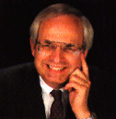
Quality Management
by A. Blanton Godfrey
Creativity, Innovation and Quality
Creativity drives the generation of ideas,
and we need new ideas constantly.
One of the most frequent questions I hear is whether we can have quality
management and creativity at the same time. Many people think that a rigorous
quality effort stifles the creative juices. Not true. Outstanding companies
drive creativity and innovation just as hard as they do quality. In fact,
many of the same concepts, methods and tools we use for quality management
are the same ones we use to drive creativity and innovation.
Any successful business needs all three. Creativity drives the generation
of ideas. We need new ideas for continuous quality improvement, to continually
reinvent our businesses and to create new goods and services.
There are a number of commonalities among creativity, innovation and quality.
We'll concentrate on just three: removing barriers, having fun and teams.
There may be no better teacher of creativity than James Adams, chair of
the values, technology, science and society department at Stanford University.
In his book, Conceptual Blockbusting, he discusses several blocks to our
creativity: perceptual; cultural and environmental; emotional; and intellectual
and expressive. We've dealt with many of these blocks in creating effective
quality improvement teams, quality design teams and high-performance work
teams.
Adams describes six types of perceptual blocks: difficulty in isolating
the problem, a tendency to delimit the problem too closely, an inability
to see the problem from various viewpoints, seeing what you expect to see
(stereotyping), saturation and failure to use all sensory inputs.
Adams discusses many different cultural and environmental blocks. Cultural
blocks include: problem solving is a serious business, and humor is out
of place; tradition is preferable to change; and any problem can be solved
by scientific thinking and lots of money.
The examples of environmental blocks he gives are far too familiar to all
of us working in quality. These blocks to creativity are the same barriers
to high-quality organizations: lack of cooperation and trust among colleagues,
autocratic bosses who value only their own ideas and do not respect others,
distractions and lack of support to bring ideas into action.
Emotional blocks are also important. These include: fear to make a mistake,
to fail, to risk; preference for judging ideas rather than generating them;
and an inability to distinguish reality from fantasy.
We quickly notice one driving force to creativity, innovation and quality
among truly successful companies. They are having fun!
Playfulness drives creativity. It is not an accident that the homes
of the greatest practical jokers in the country are the major engineering
universities such as MIT, Cal Tech and others. When I joined Bell Labs,
many of the first stories I heard about working there were the practical
jokes.
One of the strongest lessons learned by creativity and innovation researchers
and by all of us in quality management is the power of teams. Cross-functional
teams whose members bring a wide-ranging diversity to the table often astound
us with their creativity and problem-solving abilities. The leading companies
in creating new products almost all use some form of cross-functional, even
cross-company, design teams.
Hewlett-Packard is bringing together a wide range of members from different
divisions and customers of different products to create new strategic thinking
and product ideas. Ford is putting designers, engineers, lawyers, finance
people, suppliers, dealers and market researchers all together under one
roof. Companies all over the world are learning the creative power of well-run
teams.
Ideas don't just happen. If you believe they do, put up a suggestion box
on the wall and wait, and wait, and wait. Companies with numerous creative,
innovative ideas force these ideas. They create themes, focus topics, goals.
They have group sessions, discussions, brainstorming. They refuse to give
up.
The difference in organizational performance can be striking. A typical
company in the United States averages only 0.16 implemented ideas per employee
per year. Toyota Motor Co., on the other hand, averages 46 implemented ideas
per employee. Toyota achieves its remarkable record of implemented ideas
from an extremely well-organized and well-managed system.
We must unleash the imagination of everyone in our organization. We must
create the playfulness and fun to unleash this imagination. Albert Einstein
knew that great thinkers don't have to take themselves too seriously and
that: "Imagination is more important than knowledge."
About the author
A. Blanton Godfrey is chairman and CEO of Juran Institute Inc. at
11 River Road, Wilton, CT 06897. One of his favorite research areas is
creativity, innovation and quality. The text of a recent workshop on this
subject that he led with two of his colleagues at Juran Institute is on
the net at http://www.juran.com. Blan welcomes comments or questions about
this article either by fax at (203) 834-9891 or by e-mail at godfrey@netaxis.com.












